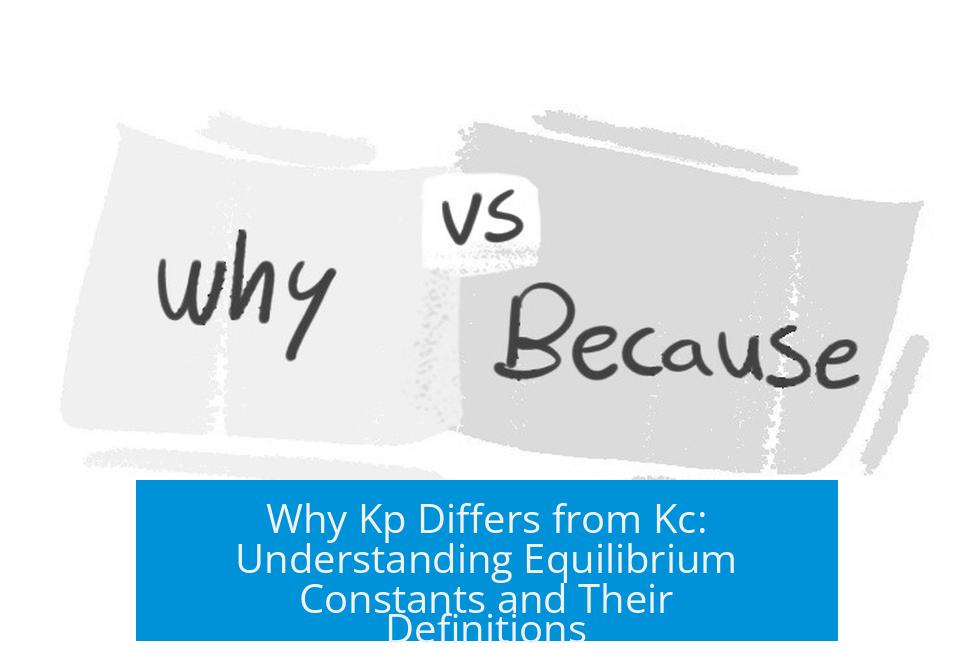Why is Kp Different from Kc (Equilibrium Constant)?

Kp differs from Kc because they use different physical quantities to express equilibrium: Kp is based on partial pressures of gases, while Kc is based on molar concentrations of substances in solution. This distinction arises from the states of matter involved and the thermodynamic implications of pressure versus concentration.
Definitions: Kp vs. Kc
- Kp is the equilibrium constant calculated using partial pressures of gaseous reactants and products, usually expressed in atmospheres or bars.
- Kc is the equilibrium constant based on molar concentrations (moles per liter) of reactants and products in solution or gas phase.
Both serve as placeholders for the true, unitless equilibrium constant that relies on activity, a thermodynamically precise measure.
Pressure, Concentration, and Activity
Pressure and concentration approximate activity under ideal conditions, but they have different standard states. Kc uses 1 Molar as the standard state, while Kp uses 1 bar (or 1 atm) of pressure, which impacts their values numerically.
This difference in reference conditions means Kp and Kc inherently reflect different physical realities. Activity, the actual effective concentration, is unitless, making the true equilibrium constant dimensionless.
Thermodynamic Basis: Entropy and Gibbs Free Energy
The variation between Kp and Kc relates to entropic effects factored into the equilibrium constant via Gibbs free energy (ΔG). Kc includes entropy related to solvation in liquids, whereas Kp reflects entropy changes in gaseous mixtures.
This distinction stems from the different ways molecules distribute and mix in gases versus solutions, affecting the equilibrium position.
Mathematical Relationship between Kp and Kc
| Condition | Relation |
|---|---|
| Change in moles of gas (Δn = 0) | Kp = Kc |
| General case | Kp = Kc × (RT)(Δn) |
- R = ideal gas constant (usually 0.0821 L·atm·mol−1·K−1)
- T = absolute temperature (Kelvin)
- Δn = change in moles of gaseous products minus reactants
This formula adjusts for the difference in units and accounts for entropy effects linked to volume and pressure changes.
Summary
- Kp uses partial pressures; Kc uses molar concentrations.
- Different standard states cause their numerical values to differ.
- Entropy differences reflect gas mixing versus solvation.
- Kp and Kc relate through (RT)^Δn, where Δn is gas mole change.
- They equal only if Δn = 0, meaning no net molecular change in gas phase.
What causes the numerical difference between Kp and Kc?
Kp and Kc differ because they use different reference states: Kp uses pressure, and Kc uses concentration. Also, they reflect different entropy effects linked to gas mixing and solvation.
When can Kp be equal to Kc?
Kp equals Kc only when the total number of moles of gaseous reactants and products does not change during the reaction. Otherwise, they differ due to the (RT)^Δn factor.
How are Kp and Kc mathematically related?
The relation is Kp = Kc × (RT)^Δn, where R is the gas constant, T is temperature, and Δn is the change in moles of gas from reactants to products.
Why are Kp and Kc unitless despite involving pressure and concentration?
Both pressure and concentration serve as placeholders for activity, which is unitless. The true equilibrium constant is activity-based, making it independent of units.
Does the choice of standard state affect Kp and Kc values?
Yes. Choosing 1 atm, 1 bar, or 1 M as the standard state changes the numerical values of Kp and Kc but not the fundamental equilibrium.





Leave a Comment